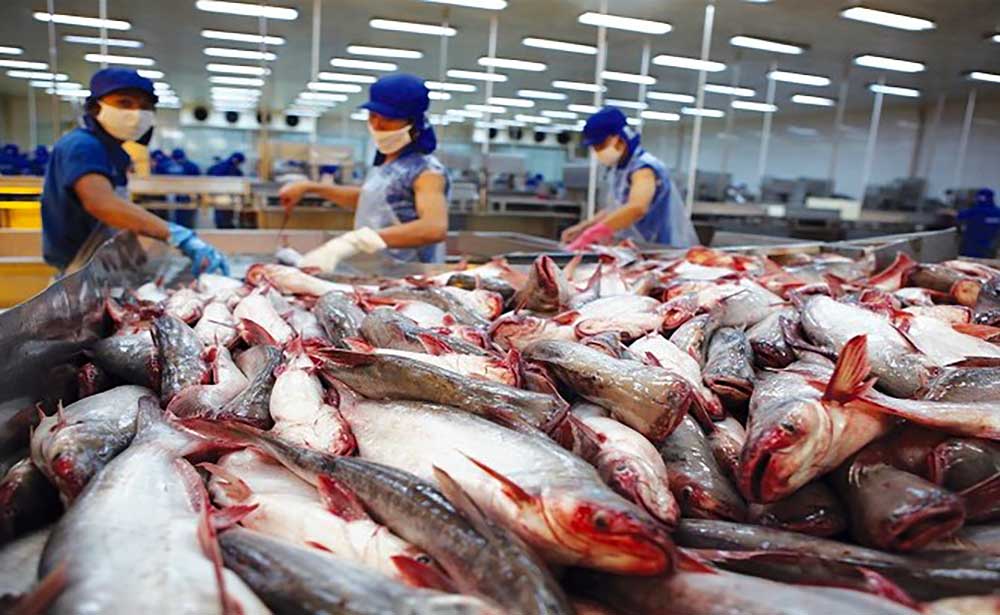In the first months of 2022, the pangasius industry has had a strong recovery. With favorable market forecasts, this industry needs to adapt quickly and urgently remove the “bottlenecks” that are still entangled in order to make the most of opportunities, especially advantages from trade agreements. free trade agreements (FTAs).
According to the Vietnam Association of Seafood Exporters and Producers, in January 2022, domestic pangasius exports have really recovered after Covid-19 with a total value of 213.6 million USD, an increase of nearly 73%. compared to the same period last year. In which, the export value in most of the major export markets grew positively. All markets recover once Covid is under control. In addition to the recovery of traditional markets, recent strong growth in emerging markets will contribute to the recovery of the fishing industry. in 2022 and the coming years.
More optimism in 2022:
Besides the advantages, according to the Directorate of Fisheries, after the Covid-19 pandemic is under control, the direct inspection activities of the Food Safety Inspection Agency (FSIS) of the US Department of Agriculture (USDA) ) for the whole chain of pangasius may be resumed. On the other hand, the General Administration of Customs of China has issued Order No. 248, on regulations on registration of enterprises to export agricultural products and foods to China, and Order 249 on measures to manage and supervise import and export food safety. of the General Administration of Customs of China based on the principle of “Safety first, prevention first, risk management, full process control and international governance” effective from January 1, 2022. may affect businesses producing and trading frozen seafood, including pangasius.
Currently, the country has nearly 120 pangasius export processing facilities with a total design capacity of 1.8 million tons of raw materials per year, most of which are located in the Mekong Delta. The facilities are equipped with modern machinery, equipment and technology, meeting the requirements and standards of the export market. Equipment and technology for producing fish oil by-products and pangasius meal are relatively modern and synchronous.
However, according to Mr. Le Thanh Hoa – Deputy Director of the Department of Agricultural Products Processing and Market Development (Ministry of Agriculture and Rural Development), the structure of export products is not reasonable. 86% (fillet, whole, cut). Enterprises have not really paid enough attention to the production of value-added products. Processing by-products into high-end products is not much. Lack of technology and equipment to produce value-added products to meet market requirements. On the other hand, due to unfair competition, product quality is reduced…
.

Improve quality and build brand:
To develop the export market for Vietnamese pangasius, Mr. Le Thanh Hoa said that it is necessary to improve the quality of pangasius products through increasing investment and applying technical advances to create safe products. ensure quality, food safety and increase the proportion of value-added products. Good production management and application of measures to reduce costs throughout the chain of production, processing and consumption of pangasius. Implement drastically the project of national catfish products in Vietnam with two important contents: improving quality and building a national brand for pangasius products.
Regarding the export market, Mr. Le Thanh Hoa said, China is no longer a low-quality market. Therefore, businesses need to well control pangasius processing and processing facilities to ensure the quality of pangasius for export. Especially in the current context, it is necessary to strictly control the presence of Covid-19 virus on products and packaging. Enhance the use of C/O form E to receive incentives from the ASEAN-China Agreement, increase the official export rate.
On the part of the authorities, it is necessary to organize the dissemination of regulations on quarantine, traceability, packaging and labeling and the tastes of the Chinese market. Well implemented the Vietnam – China Border Trade Agreement, continue to exchange and negotiate with the Chinese side to facilitate border trade. Continue to work with the Chinese side to expand the recognition of farming and processing areas and facilities as the basis for the issuance of certificates for seafood exports to this market.
For different markets, what do we need to prepare?

For the US market, it is necessary to prepare a legal dossier on the US imposing unreasonable anti-dumping tax on Vietnamese pangasius exports and the catfish inspection program violating regulations on safety and quality. food safety and plant and animal quarantine (SPS). Actively closely monitor the situation, the US moves related to the strict control of residue levels of active ingredients for imported seafood.
For the EU market, it is necessary to focus on improving product quality, building a brand, and promoting a friendly image of Vietnamese pangasius to consumers. Comply with the rules of origin to benefit from tax during the implementation of the EVFTA. Closely monitoring the situation, the EU’s move related to increasing the maximum residue level (MRL) of active ingredients for imported agricultural products. As for the authorities, it is necessary to discuss and work with the EU to propose supporting Vietnam to improve its capacity to control seafood food safety to meet EU regulations.
Particularly for the Brazilian market, this is one of the big markets for Vietnamese pangasius, requiring very high quality and willing to pay higher prices than other markets. Therefore, businesses need to increase access to and meet requirements and regulations on food quality and safety.
The Vietnam Association of Seafood Exporters and Producers forecasts that Vietnam’s pangasius export market will recover and grow well, in which, the group of 4 main markets including China, the US, CPTPP and the EU account for 73 .6% are likely to grow strongly in 2022. Export prices of fish are forecast to increase by about 5% due to costs of farming, logistics, labor, etc. Pangasius exports in 2022 are forecast to increase by 20-22% over the same period last year. 2021.



